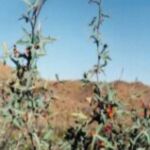| Common Name: |
Common Barberry |
| Other Names: |
Barberry, Berberidis, European Barberry, Holy Thorn, Jaundice Berry, Pepperidge Bush, Sowberry, Wood Turmeric |
| Botanical Name: |
Berberis vulgaris |
| Family: |
Berberaceae |
| Location: |
Europe, North Africa |
| Plant Facts: |
Barberry is a deciduous shrub that grows to a height of 8-10 feet. The branches bear leathery, green leaves, clusters of three thorny spikes and yellow flowers. Red berries appear in the fall. The bark of the roots is also yellow. |
| History: |
Barberry is a prized ornamental bush which produces yellow flowers in the spring and bright red fruits in the fall. The ripe fruits, rich in vitamin C, have a lemony, cranberrylike taste and are made into jams and syrups. The plant also has great commercial value. The bark yields a brilliant yellow dye which is used to color fabric and leather, and the root and bark are a significant source of berberine, a potent antibiotic effective against Escherichia coli (E. coli), Samonella, and Streptococcus. The ancient Egyptians used barberry to treat fevers and the plague, and Native North Americans drank barberry tea as a blood tonic and a treatment for debilitation, coughs, indigestion, kidney infections, rheumatism, tuberculosis, ulcers, and wounds. Native Americans also used barberry to dye animal skins, fabrics, and baskets—a practice adopted by early Spanish settlers who additionally used the plant's yellow roots to make crucifixes. |
| Origins: |
Native to Europe and North Africa, barberry is naturalized in North America. It does best in dry, sandy and lime rich soil. It is also cultivated as a garden plant. |
| Parts Used: |
The ripe berries and the bark of the stems and the roots are used for medicinal purposes. |
| Components: |
Barberry contains the alkaloids berbamine and berberine, which are responsible for the plant's yellow color. Berbamine helps to stimulate the production of white blood cells, and berberine has antiparasitic, antifungal and antibacterial properties, too. The ripe berries are also rich in vitamin C, minerals, tannins and fruit acids. |
| Indications: |
Both the roots and stems of barberry are used to treat liver and gallbladder conditions such as gallstones and jaundice. The plant can also help fight infections by stimulating white blood cells, the body's defense system, to kill fungi, bacteria and parasites. Skin wounds, cuts, eye infections including conjunctivitis and several gastrointestinal conditions, have been traditionally treated with barberry. In China, it is also being used to supplement both chemotherapy and radiation treatments for leukemia. |
| Medicinal Uses: |
Barberry has alterative, antibacterial, anticonvulsant, anti-inflammatory, antiseptic, astringent, blood-pressure-lowering, fever-reducing, laxative, liver-stimulating, sedating, tonic, uterine-stimulating, and wound-healing properties. In clinical studies, barberry has also demonstrated anticancer properties. It is considered and excellent general tonic, and one of the best—and mildest—of the liver tonics. Barberry is frequently prescribed to repair the liver and normalize liver function when there is liver damage due to alcohol abuse, disease, or infection. Barberry also stimulates the secretion of bile, thus helping the liver to rid the body of toxins. Barberry is taken internally for bacterial infections, constipation, diarrhea, dysentery, fevers, gallbladder ailments, gallstones, hepatitis, high blood pressure, liver ailments, liver tumors, and malaria. It is used externally, in eye washes and gargles, to treat conjunctivitis and other eye infections, gingivitis (gum disease), and sore throat. |
| Preparation: |
Barberry is available as dried herb and in capsules, teas, and tinctures. It is also found in several commercial eyewashes and diarrheal medications. To make a decoction, add ½ teaspoon of dried herb to 1 cup of water and boil mixture for 15 minutes. Remove from heat and steep for 5 minutes. Strain, and add honey to taste (Barberry tea is quite bitter!) Drink up to 1 cup a day, 2 tablespoons at a time. |
| Precautions: |
High doses of barberry may result in nausea, low blood pressure, headaches, and diarrhea. The herb also stimulates the uterus, so it can't be used during pregnancy.
Barberry is a uterine stimulant. Do not take the herb if you are pregnant or trying to conceive. Overconsumption of the herb can cause vomiting and dangerous drops in blood pressure. If you suspect you have a liver ailment, do not self-treat with barberry; instead, consult with a medical practitioner. Barberry is safest taken at the smallest prescribed dosage and under the advice of a medical practitioner. |
| Drug Interactions: |
Doxycycline, Tetracycline |
| Methods of Administration: |
- Tea:
To support the gallbladder and liver function, add 1 tsp. of the chopped root bark to 1 cup of water. Gently simmer 15-20 min. and strain. Drink 1 cup 1-2 times daily.
- Tincture:
For chronic gallbladder and liver ailments or a poor appetite, use 10-20 drops of tincture 15-20 min. before each meal.
- Syrup:
For constipation, fevers and coughs, cover 1 lb. of the ripe berries with water and cook until soft; strain. Add 1¾ cups of honey and simmer the mixture until a syrup forms. Pour the cooled mixture into sterilized bottles. Store the syrup in the refrigerator for 4-6 months. Take 1 tsp. up to 3 times daily.
- Skin Wash:
To make a skin wash for infected cuts, wounds and impetigo, make the tea (above); cool. Use a clean cloth to rinse the affected area with the tea 3-4 times each day. Repeat with fresh tea and another clean cloth until symptoms abate.
|
| Bibliography: |
The Complete Guide to Natural Healing Copyright © 1999 International Masters Publishers AB™ Group 1 Card 94.
The Modern Herbal Primer by Nancy Burke Copyright©2000 Yankee Publishing, Inc. pp. 109-110 |

